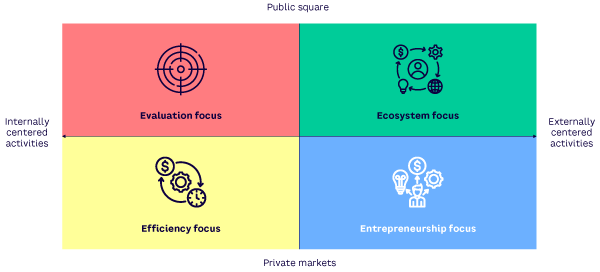Having a good map helps during any sustainability journey; this Advisor provides one in the form of a Sustainability Canvas designed to help chief sustainability officers (CSOs) and other leaders create an integrated, ongoing sustainability program that creates economic, social, and strategic value for a business and its communities.
Defining the Compass Points
Just as north, east, south, and west anchor geographic maps, the Sustainability Canvas orients around four foundational compass points. The first considers two areas of business activity: (1) those internal to the company and (2) those that interact with external audiences. Many of a firm’s internal processes, from expense report accounting to Six Sigma quality initiatives, satisfy the needs and concerns of internal stakeholders, such as employees, investors, and regulators. Other processes, such as R&D and advertising campaigns, create products or services that the business provides to external stakeholders, including customers, supply chain partners, and the communities where the business operates.
The other set of compass points considers two arenas where all businesses operate: (1) private markets and (2) the public square. All firms depend on private markets for key resources, such as supplies (from raw materials to intermediate to final goods), labor (employees and subcontractors), financial (private banks or public markets), and reputation (brand and recognition). All firms participate in the public domain as well, which includes everything from paying taxes and making voluntary philanthropic donations to following laws and regulations, using existing community infrastructure, and proactively investing in new infrastructure or resource development.
4 Destinations/Areas of Focus
Figure 1 shows the four anchors of the map and describes the four destinations (or focus areas of sustainability). We classify each focus area as its own quadrant, and many of our partners find it helpful to use the associated color scheme to name them.

The “red quadrant” (internal activities of interest to the public square) focuses on measurement and assessment, including evaluation and compliance with existing laws, norms, and regulations. Common measures of concern include carbon footprint; Scope 1, 2, and potentially 3 emissions; waste produced; and measures of social concern, such as social impact of philanthropic programs, controls for human trafficking in the supply chain, and wage and benefit fairness among employees. A sustainability report (of interest to customers, regulators, environmental/social activists) and other compliance reports constitute this quadrant’s outcome or work product.
The “yellow quadrant” (internal activities that focus on private markets) focuses on efficiency and cost reduction. The easiest way to define this quadrant is the supply chain: inbound supplies and logistics, manufacturing, and outbound logistics. This quadrant creates the data that the red quadrant captures and reports. Activities in the yellow quadrant include reducing energy use, eliminating waste, and/or improving the overall efficiency and productivity of the firm. Projects that reduce the firm’s resource footprint or improve productivity usually reduce its overall cost position over medium- or long-term time horizons. Sustainability becomes sustainable as it drives down costs and improves efficiency.
The “blue quadrant” (externally focused activities in private markets) offers a new way of thinking about sustainability for many executives. This is the quadrant of products, services, and revenue, and the question of how to leverage a company’s expertise to create new sustainability-based revenue streams too often goes unasked. Leaders can often find potential products in their yellow quadrant activities. Creating sustainability within the four walls of the firm may result in new processes (and sometimes new patentable solutions) that become the basis of monetizable innovations. At the very least, the firm may provide consulting services to other companies facing similar issues.
The “green quadrant” encompasses what in an earlier age was called “corporate social responsibility.” This is the quadrant of external activities targeting the public square (the community and larger social ecosystem in which the business operates). Philanthropy comes to mind for most people as a go-to activity to build communities, but donations are just the tip of the iceberg. For example, scholarship programs help a few in the community while mentoring and other knowledge-sharing programs benefit hundreds or thousands. One often overlooked contribution is for a company to act as a “convenor” and leverage its network connections to build awareness and critical mass around pressing issues.
The Sustainability Canvas shows how leaders can integrate their sustainability efforts. Every organization has some activity in each of the four quadrants of sustainability, and one role of a CSO lies in leveraging learning from activities in one quadrant across the map. For example, red quadrant evaluation and compliance activities may suggest low-hanging fruit for yellow quadrant efficiency-enhancing projects. Those projects may suggest potential blue quadrant products and/or services, some of which may help strengthen a green quadrant ecosystem. This represents one level of integration across quadrants. Another type of integration requires understanding how each of these quadrants creates value for both shareholders and stakeholders.
[For more from the authors on this topic, see: “Sustainable Sustainability: How to Create an Enduring & Integrated Sustainability Program.”]




